|
|
Andrés Segovia (Guitar, Arranger) |
|
Born: February 21, 1893 - Linares, Granada, Spain
Died: June 2, 1987 - Madrid, Spain |
|
Andrés Segovia, destined to become one of the greatest guitarists in music history, was born on 21 February 1893, in Linares, a small lead-mining town in the Jaen province of northern Andalusia. Shortly after his birth, his parents returned with him to their home in Jaen, but later the infant was given into the care of his childless aunt and uncle in Villacarillo, 20 miles east of Linares. Upset at being taken from the "living cradle" of his mother's arms, the child was soothed by his uncle's strumming of an imaginary guitar. As Segovia expressed it in his autobiography: "This was the first musical seed to be cast in my soul."
The boy's innate musical ability was soon noticed. When violin lessons proved unsatisfactory, he received a little, inadequate guitar tuition from an itinerant guitar player. Fortunately, around 1904 the family moved to the thriving city of Granada to ensure a proper education for Andrés, and there he acquired his first guitar as well as some elementary theory books and guitar music. His practising, despite family opposition, became ever more intense, while Granada and its Alhambra Palace profoundly impressed upon him the "beauty of life and art". Thus began a process of self-education in which Segovia was to be "both my teacher and my pupil".
Around 1909 he gave his first recital, making his debut at the Centro Artistico in Granada. After that he settled in Seville, where he met many other young artists, and gave recitals in the west of Spain - at Huelva, Jerez and Cádiz. In 1913, Segovia moved to Madrid, where, at the workshop of Manuel Ramirez, this most renowned of luthiers presented him with his first guitar of quality. Shortly after that, he made his all-important debut at the Ateneo, one of the city's most important cultural institutions - an undoubted success, though it did not attract the wide critical attention he would have liked. In Madrid, as he had done in Seville, Segovia participated in the city's flourishing artistic life, meeting a number of famous musicians and writers.
After several minor setbacks, Segovia discovered that he could attract bigger audiences with concerts in theatres or large halls rather than the small salons where guitarists usually performed. To prove his point he gave a recital at the Palau de la Musica in Barcelona, which seated over 1000 people. On returning to Madrid, he played to a capacity audience at the Ritz Hotel and consolidated his growing reputation with a performance before the Spanish royal family. With the assistance of the impresario Ernesto de Quesada (who also represented the pianist Arthur Rubinstein), he then toured northern Spain, visiting Bilbao, Vi go and Burgos. Throughout the 1920s Segovia undertook his great task of editing a large quantity of guitar music for publication, including his own transcriptions and new works by his contemporaries. Guitar Archives - Edition Andrés Segovia was launched by the house of Schott in Mainz in 1926. Segovia was particularly enthusiastic about editing and performing music by J.S. Bach, especially when he discovered H.O. Bruger's edition (1921) of the lute works.
In 1935, he premiered his own monumental transcription of J.S. Bach's Chaconne from the Violin Partita in D minor, BWV 1004. After that the guitar would never be quite the same again: critics of the instrument were confounded as the instrument attained unprecedented levels of brilliance.
Though the 1930's were a period of triumph.for Segovia and the guitar, there were also tragic experiences in his life, including the death of a young son in 1937. Having left Spain at the outbreak of the Spanish Civil War in 1936, he spent World War II (and its aftermath) in Montevideo and, later, the USA. After the war, he returned to perform once again in Europe. Arriving in Britain in 1949 to make his first long-playing albums, he was able to initiate a new phase of his recording career. The developing technology represented a distinct advance on the 78 rpm discs of little more than three minutes duration which he had made, with considerable commercial success, from 1927 until the outbreak of war. Over the next three decades (until he stopped recording, around 1977), his record companies issued over 40 LP's.
As the 1960's and the biblical span of three-score-and-ten approached and receded, the pace of Segovia's life accelerated. In 1962 he married Emilia Corral Sancho, his third wife. (Their son Carlos was born in London in 1970.) Meanwhile in Segovia's playing career a vigorous annual routine continued. Each year around February, he visited the USA, playing many recitals (including at the White House in 1979), with occasional teaching engagements. In October he usually toured Europe.
During the summer of 1986, Segovia taught master-classes for the last time at the University of Southern California in Los Angeles. Friends and former students from around the world gathered to pay tribute. On April 4, 1987 in Miami, not long after his 94th birthday, he gave his final recital. A few months later, on June 2, 1987, he died in Madrid, universally acknowledged as one of the great figures of 20th-century Spanish culture, in the company of Picasso, Falla, Casals, Dali, Mire, Lorca and Machado. His passing truly marked the end of an era. |
|
Andrés Torres Segovia, 1st Marquess of Salobreña, was a Spanish classical guitarist. He is widely regarded as one of the most important figures for the classical guitar in the beginning and mid 20th century.
Andrés Segovia said that he began playing the guitar at the age of 6. Angelo Gilardino, who has worked at the Fundación Andrés Segovia in Spain, noted: "Though it is not yet completely documented, it seems clear that, since his tender childhood, he [Segovia] learnt playing as a flamenco guitarist. In fact, the first guitar he owned had formerly been played by Paco de Lucena, the greatest flamenco guitarist of the epoque, who died when Segovia was five years old. Since then, Segovia was given some instruction by Agustinillo, an amateur flamenco player who was a fan of Paco de Lucena." As a teenager, Segovia moved to the town of Granada, where he studied the guitar and soaked up the other-worldly atmosphere of the Palace at Alhambra, a Moorish relic overlooking the town which he regarded as his spiritual awakening.
Andrés Segovia's first public performance was in Spain at the age of 16, and a few years later he held his first professional concert in Madrid, playing guitar transcriptions by Francisco Tárrega and some works by J.S. Bach, which he had transcribed and arranged himself. Although he was always discouraged by his family, and looked down on by many of Tárrega's pupils, he always continued to diligently pursue his studies of the guitar. Segovia's technique differed from that of Tárrega and his followers, such as Emilio Pujol. Both Segovia and Miguel Llobet (who taught Segovia several of his transcriptions of Granados' piano works) plucked the strings with a combination of his fingernails and fingertips, producing a sharper sound than many of his contemporaries. With this technique, it was possible to create a wider range of timbres, or tones, than when using the fingertips or nails alone. Historically, classical guitarists have debated which of these techniques is the best approach. While the majority now play with a combination of the fingernails/tips, some still prefer the convenience and mellower sound of flesh alone.
Andrés Segovia's status as a student of the guitar is a matter of debate among guitarists. The Segovia autobiography, written for mass consumption at the height of his career, depicts him as being self-taught. There are admissions of his seeking out Llobet's advice only for a short time when in his early twenties, but Segovia is quite clear about the lack of any real influence on his playing. Although at that age Segovia may well have been much more than a neophyte, he was still youthful enough to have received valuable instruction, and to have been significantly influenced by it. Indeed, RonaldPurcell points out that "Segovia, whose performance style and technique reveals [sic] the principles of Tárrega, was basically influenced by Llobet....This stylistic influence can be heard when comparing Llobet's Parlophone Electric recordings (Chanterelle Historical Recordings) with Segovia's Angel recordings, ZB 3896" (Llobet 1989).
Purcell later states, "At the age of twenty-two he (Segovia) pursued what he considered the only direct contact to Tárrega, Llobet, for refinement of his technique and especially for the music that both he and Tárrega had written and transcribed for the guitar..."(ibid). The accuracy of this date (Segovia would have been twenty-two in 1915) seems to be somewhat questionable. A photograph taken at the exhumation of Tárrega in 1915, clearly shows Segovia at the foot of the coffin, but Llobet does not appear in the photo, and would likely have been present had he, in fact, been in Spain at the time. It may well have been another two years before Segovia began to work with Llobet and there seems to be nothing that would contradict this 1917 date.
The status of the classical guitar at the beginning of the 20th century had declined, and only in Barcelona and in the Rio de la Plata region of South America could it have been said to be of any significance. When Andrés Segovia arrived on the scene, this situation was just beginning to change, largely through the efforts of Llobet. It was in this changing milieu that Segovia, whose strength of personality and artistry coupled with new technological advances such as recording, radio, and air travel, succeeded in moving the guitar forward to become more popular again.
In 1924, Andrés Segovia visited the German luthier (guitar builder) Hermann Hauser Sr. after hearing some of his instruments played in a concert in Munich. Segovia had been impressed with the quality of Hauser's work and he encouraged Hauser to copy his 1912 Manuel Ramirez guitar (an instrument generally believed to have been built by Santos Hernandez while he was foreman of the Ramirez shop). He examined and made measurements of this instrument. As Llobet, who also visited the luthier in the same year, owned an 1859 Antonio Torres, Hauser also had opportunity to examine it as well. After World War Two II, he became among the first to endorse the use of nylon strings instead of gut strings. This new advance allowed for greater stability in intonation, and was the final missing ingredient in the standardization of the instrument.
After Andrés Segovia's debut tour in the USA in 1928, the Brazilian composer Heitor Villa-Lobos composed his now well known Twelve Études (Douze études) and later dedicated them to Segovia. This proved to be a lasting relationship as H. Villa-Lobos continued to write for Segovia. He also transcribed numerous classical pieces himself and revived the pieces transcribed by men like Tárrega. Many guitarists in the Americas, however, had already been playing these same works before Segovia arrived.
In 1935, Andrés Segovia gave a premiere of Bach's Chaconne, a difficult piece for any instrument. He moved to Montevideo performing many concerts in South America in the 1930's and early 1940's. After the war, Segovia began to record more frequently and perform regular tours of Europe and the USA, a schedule he would maintain for the next thirty years of his life. In 1954, Joaquin Rodrigo composed Fantasía para un gentilhombre at the request of Segovia. Segovia won the 1958 Grammy Award for Best Classical Performance, Instrumentalist for his recording, Segovia Golden Jubilee.
In recognition of his contributions to music and the arts, Andrés Segovia was ennobled on June 24, 1981 by King Juan Carlos I, who elevated Segovia into the first hereditary Marquess of Salobreña, formally styled as "El señor don Andrés Torres Segovia, marqués de Salobreña" (the Most Illustrious Lord The Marquess of Salobreña). He was granted the following coat of arms: "en campo de azur sobre ondas de azur y plata, unas rocas de su color, sumadas de una torre donjonada de oro, aclarada de azur" (a field of azur on waves of azur and silver, rocks of the same color, plus a gold dungeon tower, with azur highlights).
Andrés Segovia continued performing into his old age, living in semi-retirement during his 70s and 80s on the Costa del Sol. Two films were made of his life and work - one when he was 75 and the other, 84. They are available on DVD called "Andrés Segovia - in Portrait". He died in Madrid of a heart attack at the age of 94. He is buried at Casa Museo de Linares, in Andalusia. |
|
"Allow me to say with pride that the guitar by being deeply Spanish is becoming universal. Spain took the guitar because the Spaniard has so rich an individuality that he is a society in himself." Andrés Segovia |
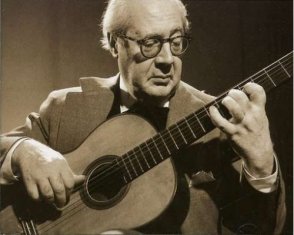
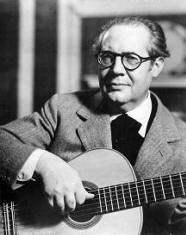

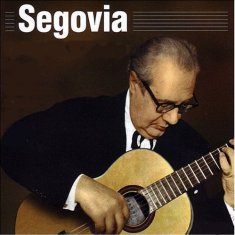
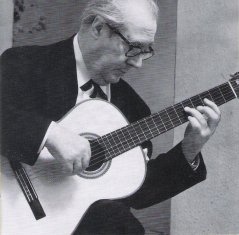
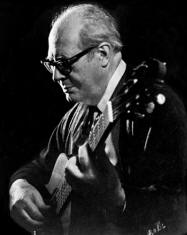
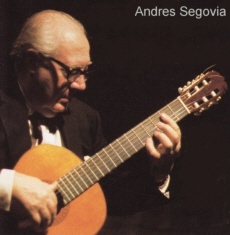
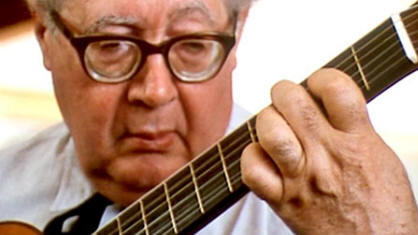 |
|
More Photos |
|
Source: Mostly Wikipedia & other websites linked below; Liner notes to the CD 'The Segovia Collection, Vol. 4 - J.S. Bach' (Deutsche Grammophon, 2002, Author: Garaham Wade)
Contributed by Aryeh Oron (June 2008) |
|
Andrés Segovia : Short Biography | Recordings of Instrumental Works |
|
Links to other Sites |
|
Museo Andrés Segovia
classicalguitar.net: Andrés Segovia
Andrés Segovia (1893-1987) The Maestro of the Guitar
Andrés Segovia page
Segovia, Andrés - Obituary (NY Times)
Segovia, Andrés Torrer (Internatiuonal Guitar Research Archive) |
Andrés Segovia (Wikipedia) [English]
Andrés Segovia (Wikipedia) [Spanish]
Andrés Segovia (Britannica Online Encyclopedia)
Andrés Segovia: Biography (Classic Cat)
Andrés Segovia - Biography (AMG) |
|
Bibliography |
|
Graham Wade : A New Look at Segovia. His Life, His Music (with Gerard Garno, 1997)
Graham Wade: Maestro Segovia (1986)
Graham Wade: Segovia: A Celebration of the Man and His Music (1983) |
|
|